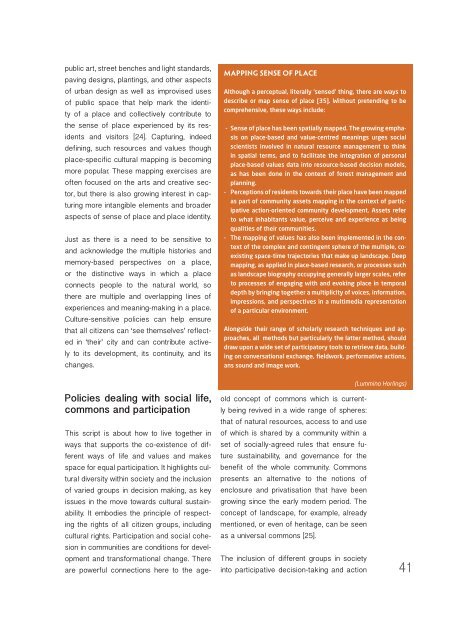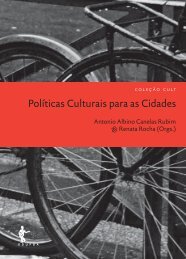Culture in for and as Sustainable Development
YIGflg
YIGflg
You also want an ePaper? Increase the reach of your titles
YUMPU automatically turns print PDFs into web optimized ePapers that Google loves.
public art, street benches <strong>and</strong> light st<strong>and</strong>ards,<br />
pav<strong>in</strong>g designs, plant<strong>in</strong>gs, <strong>and</strong> other <strong>as</strong>pects<br />
of urban design <strong>as</strong> well <strong>as</strong> improvised uses<br />
of public space that help mark the identity<br />
of a place <strong>and</strong> collectively contribute to<br />
the sense of place experienced by its residents<br />
<strong>and</strong> visitors [24]. Captur<strong>in</strong>g, <strong>in</strong>deed<br />
def<strong>in</strong><strong>in</strong>g, such resources <strong>and</strong> values though<br />
place-specific cultural mapp<strong>in</strong>g is becom<strong>in</strong>g<br />
more popular. These mapp<strong>in</strong>g exercises are<br />
often focused on the arts <strong>and</strong> creative sector,<br />
but there is also grow<strong>in</strong>g <strong>in</strong>terest <strong>in</strong> captur<strong>in</strong>g<br />
more <strong>in</strong>tangible elements <strong>and</strong> broader<br />
<strong>as</strong>pects of sense of place <strong>and</strong> place identity.<br />
Just <strong>as</strong> there is a need to be sensitive to<br />
<strong>and</strong> acknowledge the multiple histories <strong>and</strong><br />
memory-b<strong>as</strong>ed perspectives on a place,<br />
or the dist<strong>in</strong>ctive ways <strong>in</strong> which a place<br />
connects people to the natural world, so<br />
there are multiple <strong>and</strong> overlapp<strong>in</strong>g l<strong>in</strong>es of<br />
experiences <strong>and</strong> mean<strong>in</strong>g-mak<strong>in</strong>g <strong>in</strong> a place.<br />
<strong>Culture</strong>-sensitive policies can help ensure<br />
that all citizens can ‘see themselves’ reflected<br />
<strong>in</strong> ‘their’ city <strong>and</strong> can contribute actively<br />
to its development, its cont<strong>in</strong>uity, <strong>and</strong> its<br />
changes.<br />
MAPPING SENSE OF PLACE<br />
Although a perceptual, literally ‘sensed’ th<strong>in</strong>g, there are ways to<br />
describe or map sense of place [35]. Without pretend<strong>in</strong>g to be<br />
comprehensive, these ways <strong>in</strong>clude:<br />
- Sense of place h<strong>as</strong> been spatially mapped. The grow<strong>in</strong>g emph<strong>as</strong>is<br />
on place-b<strong>as</strong>ed <strong>and</strong> value-centred mean<strong>in</strong>gs urges social<br />
scientists <strong>in</strong>volved <strong>in</strong> natural resource management to th<strong>in</strong>k<br />
<strong>in</strong> spatial terms, <strong>and</strong> to facilitate the <strong>in</strong>tegration of personal<br />
place-b<strong>as</strong>ed values data <strong>in</strong>to resource-b<strong>as</strong>ed decision models,<br />
<strong>as</strong> h<strong>as</strong> been done <strong>in</strong> the context of <strong>for</strong>est management <strong>and</strong><br />
plann<strong>in</strong>g.<br />
- Perceptions of residents towards their place have been mapped<br />
<strong>as</strong> part of community <strong>as</strong>sets mapp<strong>in</strong>g <strong>in</strong> the context of participative<br />
action-oriented community development. Assets refer<br />
to what <strong>in</strong>habitants value, perceive <strong>and</strong> experience <strong>as</strong> be<strong>in</strong>g<br />
qualities of their communities.<br />
- The mapp<strong>in</strong>g of values h<strong>as</strong> also been implemented <strong>in</strong> the context<br />
of the complex <strong>and</strong> cont<strong>in</strong>gent sphere of the multiple, coexist<strong>in</strong>g<br />
space-time trajectories that make up l<strong>and</strong>scape. Deep<br />
mapp<strong>in</strong>g, <strong>as</strong> applied <strong>in</strong> place-b<strong>as</strong>ed research, or processes such<br />
<strong>as</strong> l<strong>and</strong>scape biography occupy<strong>in</strong>g generally larger scales, refer<br />
to processes of engag<strong>in</strong>g with <strong>and</strong> evok<strong>in</strong>g place <strong>in</strong> temporal<br />
depth by br<strong>in</strong>g<strong>in</strong>g together a multiplicity of voices, <strong>in</strong><strong>for</strong>mation,<br />
impressions, <strong>and</strong> perspectives <strong>in</strong> a multimedia representation<br />
of a particular environment.<br />
Alongside their range of scholarly research techniques <strong>and</strong> approaches,<br />
all methods but particularly the latter method, should<br />
draw upon a wide set of participatory tools to retrieve data, build<strong>in</strong>g<br />
on conversational exchange, fieldwork, per<strong>for</strong>mative actions,<br />
ans sound <strong>and</strong> image work.<br />
Policies deal<strong>in</strong>g with social life,<br />
commons <strong>and</strong> participation<br />
This script is about how to live together <strong>in</strong><br />
ways that supports the co-existence of different<br />
ways of life <strong>and</strong> values <strong>and</strong> makes<br />
space <strong>for</strong> equal participation. It highlights cultural<br />
diversity with<strong>in</strong> society <strong>and</strong> the <strong>in</strong>clusion<br />
of varied groups <strong>in</strong> decision mak<strong>in</strong>g, <strong>as</strong> key<br />
issues <strong>in</strong> the move towards cultural susta<strong>in</strong>ability.<br />
It embodies the pr<strong>in</strong>ciple of respect<strong>in</strong>g<br />
the rights of all citizen groups, <strong>in</strong>clud<strong>in</strong>g<br />
cultural rights. Participation <strong>and</strong> social cohesion<br />
<strong>in</strong> communities are conditions <strong>for</strong> development<br />
<strong>and</strong> trans<strong>for</strong>mational change. There<br />
are powerful connections here to the ageold<br />
concept of commons which is currently<br />
be<strong>in</strong>g revived <strong>in</strong> a wide range of spheres:<br />
that of natural resources, access to <strong>and</strong> use<br />
of which is shared by a community with<strong>in</strong> a<br />
set of socially-agreed rules that ensure future<br />
susta<strong>in</strong>ability, <strong>and</strong> governance <strong>for</strong> the<br />
benefit of the whole community. Commons<br />
presents an alternative to the notions of<br />
enclosure <strong>and</strong> privatisation that have been<br />
grow<strong>in</strong>g s<strong>in</strong>ce the early modern period. The<br />
concept of l<strong>and</strong>scape, <strong>for</strong> example, already<br />
mentioned, or even of heritage, can be seen<br />
<strong>as</strong> a universal commons [25].<br />
The <strong>in</strong>clusion of different groups <strong>in</strong> society<br />
<strong>in</strong>to participative decision-tak<strong>in</strong>g <strong>and</strong> action<br />
(Lumm<strong>in</strong>a Horl<strong>in</strong>gs)<br />
41




